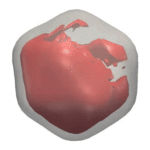Engineering artificial nanofactories modeled on bacterial microcompartments (BMCs) will require a chain of “logistical” vehicles to deliver the products. Making progress on that front, scientists affiliated with Berkeley Lab’s Molecular Biophysics and Integrated Bioimaging Division and the MSU-DOE Plant Research Laboratory have detailed the structure and function of a BMC-associated protein involved in electron transfer, a fundamental part of the assembly line that leads to the production of chemical compounds. The study, published in the journal Biochemistry, was led by Cheryl Kerfeld; Marcus Sutter also collaborated on the project. Read more from the MSU-DOE Plant Research Lab.
ALS Shines New Light on Evolution of Photosynthesis
Found in muddy soils near hot springs, Heliobacterium modesticaldum is the simplest bacterium known to be able to drive photosynthesis. Its photosynthesis reaction centers are thought to resemble the earliest common ancestor of all photosynthesis complexes, which evolved around three billion years ago. Now, for the first time, a team led by researchers from Arizona State University has obtained a near-atomic resolution (2.2 Å) structure of the membrane protein at the heart of H. modesticaldum’s photosynthetic reaction center using X-ray crystallography data collected at ALS Beamline 8.2.1. The structure gives researchers a new perspective on the early evolution of photosynthesis. Read more in this ALS Science Brief.
CRISPR Target Recognition Mechanism Illuminated Using Data From ALS
Using diffraction data obtained at Berkeley Lab’s Advanced Light Source (ALS) and at the Stanford Synchrotron Radiation Lightsource (SSRL), researchers in Biosciences’ Molecular Biophysics & Integrated Bioimaging (MBIB) division and at UC Berkeley have discovered how CRISPR-associated (Cas) proteins are able to recognize their target locations with such great specificity. X-ray crystallography was used to solve the structures of Cas1 and Cas2—responsible for DNA-snippet capture and integration—as they were bound to synthesized DNA strands designed to mimic different stages of the process. The resulting structures show how the system works in its native context as part of a bacterial immune system, and also inform the development of the CRISPR-Cas system as a general-purpose molecular recording device. Jun-Jie Liu, a joint postdoc in the labs of Jennifer Doudna and Eva Nogales, and Addison Wright, a graduate student in Doudna’s lab, were co-first authors on the paper, published in the journal Science. Read more in this ALS Science Highlight.
NIH Awards $6.5 Million for Augmenting Structural Biology Research Experience
The National Institutes of Health (NIH) has awarded $6.5 million to Berkeley Lab to integrate existing synchrotron structural biology resources to better serve researchers. The grant will establish a center based at the Lab’s Advanced Light Source (ALS) called ALS-ENABLE that will guide users through the most appropriate routes for answering their specific biological questions.
M-TIP Algorithm Enables New Approach to Imaging Single Biological Particles
As part of an international team, researchers with Berkeley Lab’s Center for Advanced Mathematics for Energy Research Applications (CAMERA) employed their multi-tiered iterative phasing (M-TIP) algorithm to process X-ray free laser (XFEL) data taken from single virus particles and resolve their nanometer-scale structures in 3D. The new approach circumvents several challenges of imaging biomolecules that do not crystallize well, such as the random orientations of particles in solution and the asymmetrical structures of many viruses and proteins. Jeff Donatelli of the Computational Research Division’s Mathematics Group and Peter Zwart and Kanupriya Pande of the Biosciences Area’s Molecular Biophysics and Integrated Bioimaging (MBIB) division contributed to the work, the results of which were published in Physical Review Letters. Read more from the Berkeley Lab News Center.
- « Previous Page
- 1
- …
- 49
- 50
- 51
- 52
- 53
- …
- 78
- Next Page »
Was this page useful?








